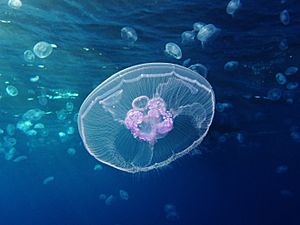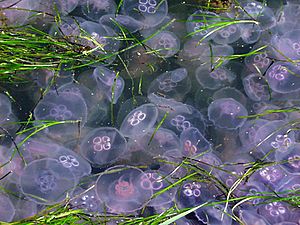Aurelia (cnidarian) facts for kids
Quick facts for kids Aurelia (cnidarian) |
|
|---|---|
 |
|
| Adult Aurelia aurita medusa | |
| Scientific classification |
|
| Kingdom: | Animalia |
| Phylum: | Cnidaria |
| Class: | Scyphozoa |
| Order: | Semaeostomeae |
| Family: | Ulmaridae |
| Genus: | Aurelia Lamarck, 1816 |
| Species | |
|
|
Aurelia is a group of jellyfish often called moon jellies. They belong to a class of jellyfish known as Scyphozoa. There are about 25 known types, or species, of moon jellies. Scientists are still finding and describing new ones!
These amazing creatures live in oceans all over the world. You can find them in the Atlantic, Arctic, Pacific, and Indian Oceans. They are most common in places with mild weather, like off the coasts of Japan, New Zealand, and parts of Europe and the United States.
Contents
What Do Moon Jellies Look Like?
Moon jellies can be tricky to tell apart because they look so similar. They come in different sizes, but most are about 5 to 38 centimeters (2 to 15 inches) wide. On average, an adult moon jelly is about 18 cm (7 inches) wide and 8 cm (3 inches) tall.
Young moon jellies, called polyps, can grow up to 1.6 cm (0.6 inches) tall. Their tiny baby jellyfish forms, called ephyrae, are usually about 0.4 cm (0.16 inches) across.
Adult moon jellies are usually clear, or translucent. But their color can change depending on what they eat! If they eat tiny crustaceans, they might look pink or purple. If they eat brine shrimp, they could have an orange tint. Their polyps usually have about 16 tentacles, which help them catch food.
How Moon Jellies Find Food
Moon jellies eat in a similar way to other jellyfish. Their main food is zooplankton, which are tiny animals that float in the water.
Sometimes, large groups of moon jellies can cause problems for fishing boats. They can clog and damage fishing nets. This might make fishermen have to move to different areas to find fish.
Special Features of Moon Jellies
Moon jellies have special parts called rhopalia around the edge of their bell. These help them sense light and dark, and know which way is up or down.
Scientists have studied the venom of Aurelia aurita, a common moon jelly. This venom can make muscles twitch. It works by changing how the muscle cells react, causing them to move without control.
The Life Cycle of Moon Jellies

Adult moon jellies reproduce sexually. Male jellies release tiny strings of sperm into the water. Female jellies then take in these sperm. After the eggs are fertilized, tiny larvae (baby jellies) develop. These larvae have tiny hairs that help them swim.
The larvae then settle down on the seafloor or nearby. There, they grow into small polyps. These polyps can then reproduce without a partner, making more polyps. They also bud off tiny, star-shaped baby jellyfish called ephyrae. These ephyrae then grow into the adult moon jellies we see swimming in the ocean.
See also
- Gelatinous zooplankton


